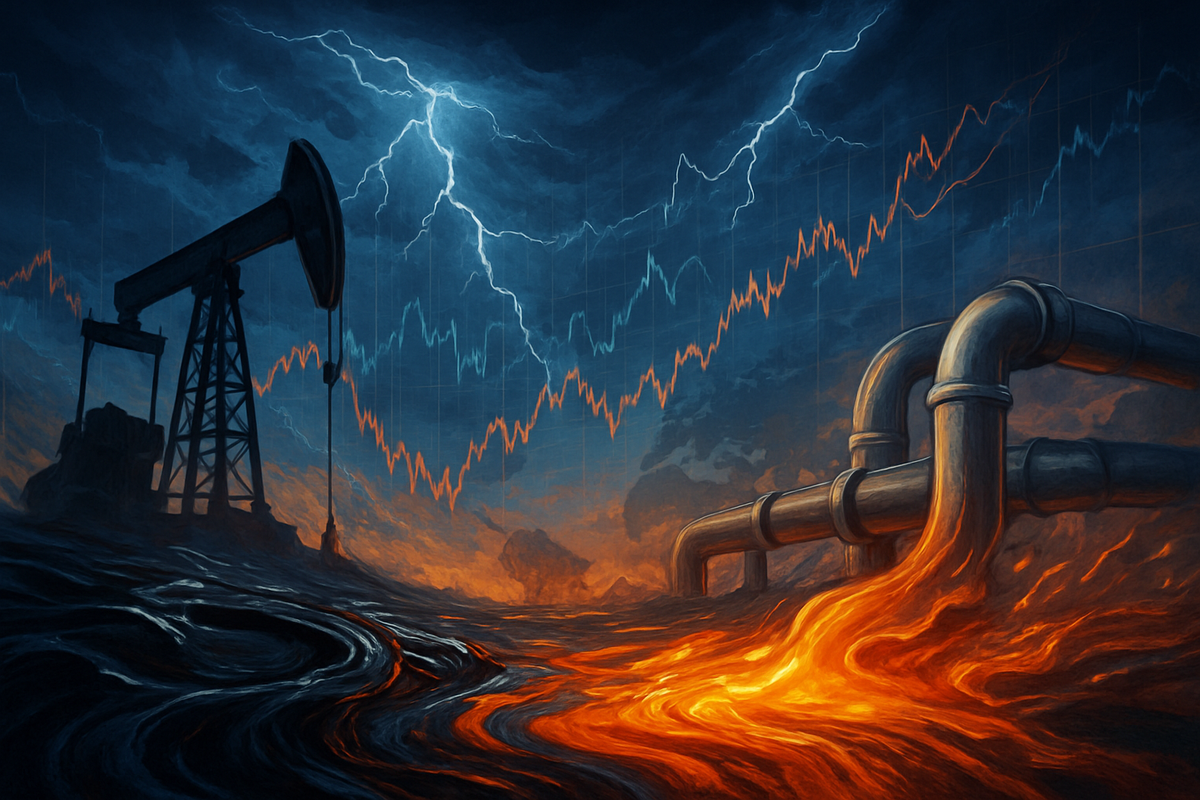
The S&P 500 Energy sector finds itself once again at the nexus of global forces, with its performance today, and indeed in the foreseeable future, inextricably linked to the unpredictable dance of commodity prices, geopolitical maneuvering, and shifting global demand. While specific real-time performance data remains elusive at the closing bell on October 27, 2025, the underlying currents suggest a sector perennially poised for significant swings. Investors and market watchers are keenly aware that this segment of the market, home to titans like ExxonMobil (NYSE: XOM) and Chevron (NYSE: CVX), is a barometer for broader economic health and international stability, often delivering both exhilarating gains and precipitous declines.
The inherent volatility of the Energy sector is not merely a characteristic but a defining feature, driven by an intricate web of external factors that can pivot its trajectory with remarkable speed. The price of crude oil, for instance, remains the single most dominant influence, directly dictating the revenue and profit margins of exploration and production companies. A surge in oil prices often translates to a robust performance for the sector, while a downturn can quickly erode earnings and investor confidence. Similarly, natural gas prices, though more domestically driven, exhibit their own susceptibility to weather patterns and storage levels, with emerging demands from energy-intensive industries like AI data centers now adding a new layer of complexity. Geopolitical flashpoints, from regional conflicts to international sanctions, invariably inject a premium of uncertainty and risk into the market, frequently leading to supply disruptions that send prices soaring. Meanwhile, the overarching health of the global economy serves as the fundamental engine for energy demand; robust economic growth fuels consumption, while slowdowns inevitably dampen it, creating a cyclical pattern of boom and bust that defines the sector's rhythm.
The Unseen Hand: Commodity Prices, Geopolitics, and Demand's Grip
The intricate dance of commodity prices, geopolitical events, and global demand forms the bedrock of the S&P 500 Energy sector's dynamic nature. Crude oil prices, in particular, serve as the sector's pulsating heart. The profitability of major players like ExxonMobil (NYSE: XOM), Chevron (NYSE: CVX), and ConocoPhillips (NYSE: COP) is directly correlated with the per-barrel price of oil. When crude oil futures ascend, the financial outlook for these integrated oil and gas giants, as well as pure-play exploration and production (E&P) firms, brightens considerably, attracting investor capital and boosting stock valuations. Conversely, any significant dip in oil prices can rapidly depress earnings forecasts and trigger a sell-off. This direct correlation was starkly evident in recent years, with the S&P 500 energy sector witnessing annual returns ranging from a steep -33.68% in 2020 amid pandemic-induced demand shocks to an impressive 65.72% in 2022 following supply constraints and recovering demand, closely mirroring the volatile journey of crude prices. Beyond the headline price, supply and demand fundamentals are critical; an oversupply can crush margins, while refiners are more sensitive to the spread between crude and refined products.
Natural gas, while often overshadowed by crude oil, plays a significant, albeit more domestically focused, role in the sector's performance. Unlike the globally traded oil market, natural gas prices are predominantly shaped by North American supply and demand dynamics. Short-term weather forecasts, particularly during peak heating or cooling seasons, can dramatically sway prices. Cooler-than-anticipated winter forecasts, for instance, can send natural gas prices spiraling upwards as demand for heating surges, directly benefiting natural gas producers and distributors. Conversely, robust storage levels indicating ample supply can exert downward pressure. The burgeoning demand from energy-intensive sectors, such as the rapidly expanding network of AI data centers, is emerging as a new and potentially accelerating driver for natural gas consumption, offering fresh opportunities for companies focused on this commodity. This growing demand can sometimes enable natural gas stocks to lead the broader energy sector, even amidst a more pessimistic outlook for oil.
Geopolitical events, perhaps more than any other factor, inject an element of unpredictable volatility into the energy markets. Tensions in major oil-producing regions, international sanctions against key energy exporters, or even trade disputes can trigger immediate and significant reactions in crude oil futures. The mere threat of supply disruptions, whether from conflict in the Middle East or political instability in a major producing nation, is often enough to tighten global markets and push prices higher, leading to a robust, albeit often short-lived, rally in the S&P 500 Energy sector. The ongoing geopolitical risks, including regional conflicts and strategic alliances like OPEC+, ensure that the energy market remains a hotbed of uncertainty, with rapid and often dramatic price swings becoming the norm. These events not only impact immediate supply but also influence long-term investment decisions and strategic adaptations by energy companies.
Finally, global demand acts as the overarching economic current guiding the sector. The health of the world economy is a fundamental determinant of energy consumption. Periods of robust global economic growth typically translate into increased industrial activity, higher transportation needs, and greater overall energy demand, which in turn supports higher commodity prices and improved performance for energy companies. Conversely, economic slowdowns or recessions can significantly dampen demand, leading to price declines and putting considerable pressure on energy stock valuations. Furthermore, energy prices have a significant residual impact on broader inflationary pressures, as they are a key input for transportation and manufacturing across almost all industries. Long-term demand forecasts, such as the International Energy Agency's predictions of oil demand peaking by 2029 due to the proliferation of renewable energy and electric vehicles, also influence investor sentiment and compel energy companies to consider diversification strategies towards lower-carbon energy sources to mitigate future shifts in demand.
Navigating the Shifting Sands: Potential Winners and Losers
In an environment defined by such potent external forces, the S&P 500 Energy sector sees a constant reshuffling of potential winners and losers. Companies with diversified portfolios and robust balance sheets are often better positioned to weather the storms of volatility. Integrated oil and gas majors like ExxonMobil (NYSE: XOM) and Chevron (NYSE: CVX) typically benefit from higher crude oil prices due to their extensive upstream (exploration and production) operations. Their sheer scale and vertical integration – encompassing refining, chemicals, and marketing – can also provide a hedge, as refining margins might improve when crude prices fall, though this is not always a perfect offset. These companies are also often more resilient to geopolitical shocks due to their global footprint and ability to source from various regions.
On the other hand, pure-play exploration and production (E&P) companies, such as EOG Resources (NYSE: EOG) or Pioneer Natural Resources (NYSE: PXD), are highly sensitive to commodity price fluctuations. When oil and gas prices rise, their profitability can surge dramatically, leading to significant stock appreciation. However, a sustained downturn in prices can quickly erode their margins, impact their ability to fund new projects, and put severe pressure on their stock performance. Their fortunes are almost entirely tied to the price deck of crude oil and natural gas. Similarly, oilfield services companies like Schlumberger (NYSE: SLB) and Halliburton (NYSE: HAL) see their business directly correlated with the activity levels of E&P firms. When commodity prices are high, E&P companies increase drilling and production, leading to higher demand for services. Conversely, a cutback in capital expenditures by producers directly impacts the service providers.
Companies with significant exposure to natural gas, like EQT Corporation (NYSE: EQT), could see a boost from increasing domestic demand, particularly if the growth in AI data centers translates into sustained higher natural gas consumption. Their fortunes, however, remain tied to regional weather patterns and storage levels. Midstream companies, which operate pipelines and storage facilities, such as Enterprise Products Partners (NYSE: EPD) or Kinder Morgan (NYSE: KMI), often exhibit more stable revenue streams as their business models are typically based on long-term contracts and volumes transported rather than the fluctuating price of the commodities themselves. They are more insulated from price volatility but can be affected by overall production levels and regulatory changes impacting infrastructure development. The ongoing push towards energy transition also creates a dichotomy; companies actively investing in renewable energy or carbon capture technologies might see long-term benefits, while those heavily reliant on traditional fossil fuels without a clear transition strategy could face increasing investor scrutiny and potential devaluation.
Beyond the Barrel: Wider Significance and Industry Trends
The Energy sector's current state and its inherent volatility extend far beyond the immediate financial performance of individual companies, echoing through broader industry trends, regulatory landscapes, and even historical precedents. This ongoing dynamism fits squarely into a larger narrative of global energy transition, geopolitical realignment, and the persistent influence of supply-demand economics. The push towards decarbonization and renewable energy sources, while a long-term trend, constantly casts a shadow over the traditional fossil fuel industry. This creates a dual pressure: on one hand, the world still heavily relies on oil and gas for its primary energy needs, ensuring continued demand; on the other, increasing environmental regulations and investor pressure for ESG (Environmental, Social, and Governance) compliance force energy companies to adapt, diversify, or risk becoming stranded assets.
The ripple effects of energy sector volatility are profound, impacting not only direct competitors but also a vast ecosystem of partners and downstream industries. High energy prices can squeeze the margins of airlines, transportation companies, and manufacturers, acting as an inflationary force across the economy. Conversely, low prices can provide a cost advantage, stimulating economic activity. Regulatory and policy implications are equally significant. Governments worldwide grapple with the delicate balance of ensuring energy security, promoting economic growth, and meeting climate targets. Policies related to drilling permits, emissions standards, carbon pricing, and subsidies for renewable energy can directly impact the operational costs and investment decisions of energy companies. Geopolitical events, such as the ongoing conflict in Ukraine or tensions in the Middle East, serve as stark reminders of how quickly global energy supply chains can be disrupted, leading to calls for greater energy independence and diversification of sources among consuming nations.
Historically, the energy market has always been cyclical, characterized by periods of boom and bust. The oil crises of the 1970s, the Asian financial crisis in the late 1990s, and the 2008 financial crisis all demonstrated the sector's sensitivity to global economic health and geopolitical shocks. More recently, the sharp decline in oil prices in 2014-2016 due to oversupply from U.S. shale production, followed by the unprecedented demand destruction during the 2020 pandemic, and then the subsequent surge in prices, highlight the rapid and often unpredictable nature of this market. These historical precedents underscore that while the specific triggers may evolve, the fundamental drivers of volatility – supply, demand, and geopolitics – remain constant. The industry is constantly recalibrating, with major players often engaging in mergers and acquisitions to consolidate market share, optimize portfolios, and gain efficiencies, as seen with recent large-scale deals aimed at enhancing scale and resilience in a turbulent market.
The Road Ahead: Navigating Future Energy Landscapes
Looking ahead, the S&P 500 Energy sector faces a landscape brimming with both challenges and opportunities, demanding strategic pivots and adaptive measures from its constituents. In the short term, market participants will be closely monitoring geopolitical developments, particularly any escalations in existing conflicts or the emergence of new flashpoints that could impact global supply routes. Decisions by OPEC+ regarding production quotas will also remain a critical determinant of crude oil prices, directly influencing the immediate profitability of oil producers. Weather patterns across major consuming regions will similarly play a pivotal role in shaping natural gas demand and price stability. Companies with strong hedging strategies and diversified revenue streams will likely be better positioned to absorb sudden shocks.
In the long term, the energy transition will undoubtedly be the most profound force shaping the sector. The accelerating adoption of renewable energy technologies, the electrification of transportation, and advancements in energy storage are poised to gradually reshape global energy demand. This necessitates significant strategic pivots for traditional fossil fuel companies. Many are already investing heavily in lower-carbon solutions, including carbon capture and storage, hydrogen production, and renewable energy projects, to diversify their portfolios and align with evolving environmental mandates. This shift presents both a challenge to their core business models and a significant market opportunity for those who can successfully innovate and adapt. Companies that fail to evolve risk facing increasing regulatory burdens, investor divestment, and a diminishing market share.
Potential market opportunities may emerge from technological advancements that improve extraction efficiency, reduce operational costs, or facilitate the development of new energy sources. For instance, enhanced oil recovery techniques or innovations in liquefied natural gas (LNG) export infrastructure could provide competitive advantages. Furthermore, the increasing global energy demand, particularly from developing economies, will ensure a continued need for traditional energy sources for decades, albeit within a more diversified energy mix. The challenge lies in balancing this persistent demand with the imperative for decarbonization. Investors should prepare for a future characterized by continued, albeit perhaps different, forms of volatility, driven by policy shifts, technological breakthroughs, and the ongoing geopolitical dynamics of resource control. Scenarios could range from a smooth, managed transition to a more abrupt, disruptive shift, each carrying distinct implications for the sector's profitability and investment appeal.
A Sector in Flux: Key Takeaways and Future Watchpoints
The S&P 500 Energy sector remains a compelling, yet complex, component of the broader market, defined by its acute sensitivity to a trifecta of influential factors: commodity prices, geopolitical stability, and global demand. Today's closing bell report, in the absence of specific real-time performance data, underscores the sector's fundamental nature as a high-beta play, capable of both outsized gains and significant drawdowns. The key takeaway for investors is the absolute necessity of understanding these underlying drivers, as they are the primary architects of the sector's trajectory. Companies with robust balance sheets, diversified operations, and a clear strategy for navigating the energy transition are best positioned to thrive amidst this inherent volatility.
Moving forward, the market will continue to assess the energy sector through a multifaceted lens. Investors should closely monitor the trajectory of global economic growth, as it directly correlates with energy consumption. Any signs of a slowdown could signal headwinds, while renewed growth could provide tailwinds. Geopolitical developments, particularly in major oil-producing regions, will remain critical watchpoints, as they can trigger rapid supply shocks and price spikes. Furthermore, the evolving regulatory landscape surrounding climate change and carbon emissions will increasingly influence investment decisions and corporate strategies. The pace of technological innovation in renewable energy and carbon abatement will also be a key factor, potentially accelerating the energy transition and creating new competitive dynamics.
Ultimately, the significance of the Energy sector extends beyond its market capitalization; it is a vital artery of the global economy. Its lasting impact will be shaped by how effectively it can meet the world's ongoing energy needs while simultaneously adapting to the imperative of a lower-carbon future. For investors, this means maintaining a vigilant watch on commodity market fundamentals, geopolitical headlines, and the strategic adaptations of individual companies. The coming months will undoubtedly offer further insights into how these powerful forces will continue to sculpt the fortunes of the S&P 500 Energy sector.
This content is intended for informational purposes only and is not financial advice







